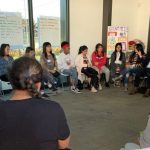For the past 2 years Mrs. Pham and her family have been fighting eviction from their home in Chinatown. Mrs. Pham is 71 years old, and has lived with her daughter and 2 grandchildren in a small apartment building, where most of the tenants are low-income refugee families. Her family has been harassed by their landlord who has served eviction notices, and refused to accept rent checks – a common tactic to evict tenants. Instead of sheltering safely at home during the COVID19 pandemic, Mrs. Pham, who also suffers from diabetes and high blood pressure, finds herself in a battle to stay housed, and worried that there is nowhere affordable to go.
Sadly, this story is not unique. Southeast Asian Community Alliance (SEACA), a nearly 20-year-old organization working directly with low-income families and seniors, has seen the effects of the housing crisis in Chinatown firsthand. In the last few years, rents have risen dramatically, in some cases doubling within a few months, pushing out long-term residents and irreversibly changing the face of the community.
When the City began it’s planning process to update the Downtown Community Plan (which includes Chinatown) 5 years ago, SEACA joined with fellow advocates in the Downtown communities of Little Tokyo and Skid Row to form the Central City United (CCU) Coalition and advocate for a People’s Plan for a Downtown Los Angeles that would uplift the voices and meet the needs of low-income, immigrant, and refugee communities and residents, like Mrs. Pham. The coalition has spent hundreds of hours holding community meetings, focus groups, and collecting surveys in 7 languages with small business owners, workers, youth, families and seniors to inform the People’s Plan’s recommendations to the City.
How does the People’s Plan advocate for more affordable housing?
CCU and SEACA are advocating for a Downtown Community Plan that creates a system where every time a new housing development is built, it includes homes affordable to low-income community members. The People’s Plan demands that affordable housing be tied to future development, and that the definition of “affordable” includes homes that are accessible for the most vulnerable members of our community.
The People’s Plan prioritizes housing for low-income families and seniors on fixed incomes, while maintaining and uplifting our entire community through future development, and ensuring a return-on-investment for those who invest in Chinatown. The City incorporated this idea into the official Draft Plan and created an affordable housing incentive program. Under this incentive system, by linking development incentives to community benefits (such as affordable housing), when a developer includes affordable housing in a new project, they also get perks such as:
- Being allowed to build more total housing units in a building,
- Being allowed to build taller buildings with more housing, and
- Having a simplified building process so more construction happens sooner, and fewer projects are bogged down in bureaucracy.
Why are some Chinatown property owners against the City’s Plan?
However, despite many years of CCU community engagement and working with the City to develop this incentive program, some Chinatown property owners are unhappy about the City linking development perks to the inclusion of affordable housing units. They have been misleading community members and city leaders by claiming the City’s Draft Plan would ‘take away’ their ability to build bigger projects – a right they feel entitled to; and claiming that affordable housing is ‘not feasible’ in Chinatown. These assertions are simply untrue.
- The City is not ‘taking’ rights away from developers. It is entirely within the purview of the City to make decisions about what land can be used for, how tall buildings can be, how much parking must be provided, etc. In the old Plan, developers were simply given a cap for how big they could build. The new proposal is much more nuanced and calculated towards a beneficial kind of development that takes community needs into account while still promoting growth. Instead of capping the size of the project, the new Draft Plan builds in thresholds; if they want to tap into additional development perks, developers have to include affordable units, or other community benefits. Even a study commissioned by the City points out that the new Plan does not overly burden developers, or impose unfair requirements.
- Building affordable housing is feasible in Chinatown, and will only become more so over time. The same study shows that the inclusion of affordable housing is possible under the new Plan, and that as market conditions change over time in Chinatown, affordable housing will become even more profitable to build. The most recent version of the City Plan even removes height restrictions on building, in order to promote affordable housing development.
The future of Chinatown depends on more affordable housing
The reality is that Chinatown is a dynamic community of residents, workers, and small businesses. It is also one of the poorest communities in Los Angeles where many residents live close to, or below, the poverty line. In order to grow and thrive, future development must support our low-income refugee and immigrant community, not exacerbate displacement and gentrification. The people, not buildings, make Chinatown a community, and should be the focus of community planning. The business-as-usual approach has not produced the affordable housing our community needs. Property owners and developers like to say that they are invested in the well-being of the neighborhood and the people. The proposed Plan offers a chance to start solving our profound affordable housing crisis while promoting growth. Families like Mrs. Pham’s should not have to worry about being able to stay in their home and their community. Chinatown needs more affordable housing, the People’s Plan is the way forward.


